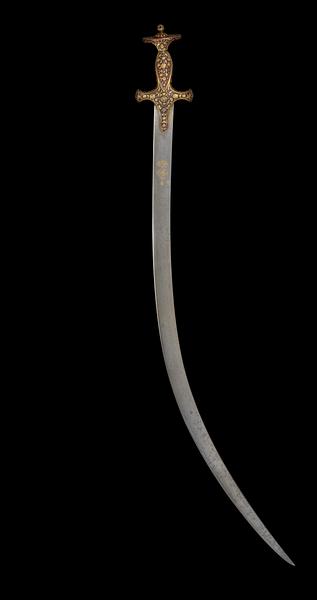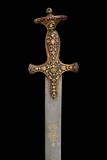The blade of this sabre is made of watered crucible steel, also known as
wootz steel. The inlaid gold inscriptions state that it was commissioned by Safdar Jang Bahadur and made by Muhammad Baqir Mashhadi in 1163. At the time of writing, there are nine known published sabres with almost identical inscriptions, of which six are fitted with
shamshir hilts and three with
tulwar hilts.
[1] They were forged while the Persian-born Safdar Jang was
nawwab of Awadh and vizier to the Mughal emperor Ahmad Shah (1748–53), but whether the likewise Persian-born Muhammad Baqir produced them in Delhi or in one of the cities of Awadh is not known. Indian weaponsmiths did not usually sign their blades, whereas the practice was more widespread in the Iranian and Ottoman realms. Whether the sabres were intended for Safdar Jangs guard or as gifts is also a matter of conjecture.
The characteristic, Indian
tulwar hilt is dominated by a large pommel disk. This one has a tang nut, to which an eyelet with a wrist strap would originally have been attached. The swelling grip joins the short guard and the langet in forming a cruciform shape. The entire hilt, which is made of iron, is inlaid with flowers, stems and leaves as well as carefully delimited lines of gilt copper raised in relatively high relief. Some
tulwars also feature protective hand guards. Stylistically, the hilt appears older than the blade. Replacing parts of sabres and daggers over time or reusing old ones was a common practice.


